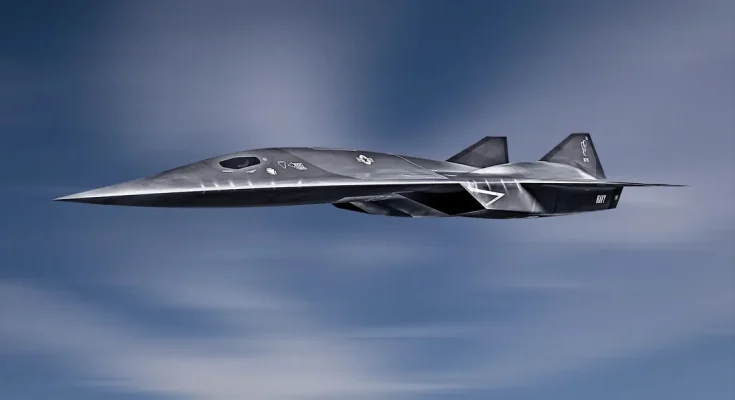After years of speculation and secrecy surrounding Lockheed Martin’s hypersonic aircraft program, the U.S. Air Force has officially confirmed the existence of the SR-72 Darkstar, an advanced aircraft designed to fly at speeds beyond Mach 6, and potentially revolutionize aerial combat and reconnaissance missions. The SR-72 is seen as a successor to the legendary SR-71 Blackbird, famous for its high-speed, high-altitude reconnaissance capabilities during the Cold War. Now, as part of a new era in hypersonic technology, the SR-72 is set to redefine the future of military aviation.
What is the SR-72 Darkstar?
The SR-72 Darkstar is a hypersonic aircraft developed by Lockheed Martin’s renowned Skunk Works division. Building on the lessons learned from the SR-71 Blackbird, the SR-72 is designed for extremely high-speed, high-altitude flight, intended for use in both reconnaissance and strike roles. Unlike traditional aircraft, the SR-72 employs a revolutionary propulsion system that integrates a dual-mode scramjet engine, capable of reaching speeds exceeding Mach 6 (around 4,600 miles per hour).
This speed enables the Darkstar to cover vast distances rapidly, making it an invaluable asset for surveillance and precision strikes in hostile environments. Its hypersonic speed would allow it to avoid enemy defenses and interceptors, which have difficulty tracking objects moving at such velocities.
Technological Advancements
At the heart of the SR-72’s design is its hypersonic propulsion system, which utilizes a combination of jet and scramjet technologies. Scramjets (Supersonic Combustion Ramjets) are an advanced form of air-breathing engines that allow an aircraft to maintain supersonic speeds at extremely high altitudes, providing the SR-72 with unmatched range and speed capabilities.
Another crucial component of the SR-72 is its advanced materials. The aircraft is designed with specialized heat-resistant materials to withstand the extreme temperatures generated by hypersonic flight. At speeds greater than Mach 5, friction with the air creates temperatures that would melt most conventional materials. The SR-72’s heat-resistant skin and structure are engineered to handle these extreme conditions, enabling it to remain operational under such harsh conditions.
Strategic Importance
The SR-72’s speed and advanced capabilities have significant strategic implications. At hypersonic speeds, the aircraft can evade even the most advanced air defense systems, including surface-to-air missiles and fighter jets. This gives it a unique advantage in delivering reconnaissance data or striking high-value targets deep within enemy territory without risking the loss of the aircraft.
Additionally, the SR-72 could serve as a platform for delivering precision-guided weapons or conduct surveillance missions, gathering critical intelligence over vast regions in a fraction of the time it would take other aircraft. Its role would not only be limited to military operations; it could potentially be used for high-speed global reconnaissance, providing real-time data from across the globe.
Development and Testing Timeline
While the SR-72 has been under development for several years, the U.S. Air Force has confirmed that test flights are expected within the next few years, with operational deployment likely to occur in the early 2030s. The aircraft’s advanced technology, including the scramjet engine and the integration of cutting-edge avionics, has presented significant challenges, but the Air Force and Lockheed Martin are making steady progress.
Due to the highly classified nature of the program, many details about the SR-72 are still under wraps, but various reports and expert speculation suggest that the aircraft will enter service as a key player in the U.S. military’s global operations, filling roles in reconnaissance, surveillance, and rapid-response strike missions.
Why Does the SR-72 Matter?
The SR-72 represents a leap forward in the U.S. Air Force’s capabilities in the realm of high-speed flight. As adversaries like China and Russia invest in hypersonic technologies, the SR-72 could provide the U.S. with a crucial edge in terms of speed, stealth, and operational flexibility. Its ability to evade detection and strike quickly and effectively gives it a powerful role in modern warfare, whether it be for strategic deterrence, intelligence gathering, or precision strikes on high-value targets.
The SR-72 also holds potential for future technologies that could further expand its capabilities. Hypersonic flight could be integrated into both manned and unmanned missions, transforming the way the U.S. military conducts operations worldwide. Its emergence is expected to be a major milestone in the evolution of aerospace technology.
Conclusion
The SR-72 Darkstar is no longer a mere concept; it is a reality that will shape the future of military aviation. As the U.S. Air Force officially recognizes its existence, the SR-72’s hypersonic capabilities mark a new chapter in the history of flight. With its unparalleled speed and versatility, this aircraft promises to be a game-changer for global military operations, enhancing U.S. capabilities in reconnaissance, strike missions, and overall air superiority. As we move into a new era of warfare, the SR-72 stands as a testament to the ongoing pursuit of technological innovation and the future of high-speed, stealthy flight.



